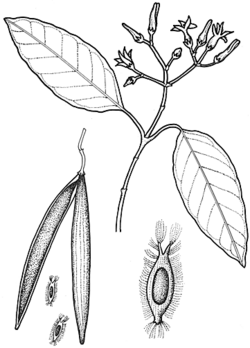Common name: Bitter Bark, Quinine Tree, Quinine Bush
Alstonia constricta F.Muell. APNI* 
Description: Erect shrub or tree to 12 m high, often suckering and forming thickets; bark fissured, corky.
Leaves opposite, narrow-lanceolate to narrow-elliptic or oblong-elliptic, 6–18 cm long, 7–45 mm wide, apex ± acuminate, margins undulate, soft and thin, glabrous to pubescent; petiole 1–5 cm long.
Flowers whitish, scented. Calyx lobes 1 mm long. Corolla tube 2–3 mm long, lobes 6–10 mm long, narrow, obtuse.
Follicles compressed, 6–24 cm long, c. 10 mm wide.
Flowering: spring.
Distribution and occurrence:
NSW subdivisions: NC, NT, NWS, CWS, NWP
Other Australian states: Qld
Extracts of the bark were used by pioneer settlers in treating fevers; the plant is reported to be poisonous to stock if eaten.
Text by G. J. Harden & J. B. Williams
Taxon concept:
| | Key to the informal variants | |
| a | Plants with glabrous leaves, usually >12 mm wide and petiole >20 mm long. In dry and littoral rainforest on the coast north from Woolgoolga and in western woodland and scrub | Type form |
| b | Plants with sparsely to densely pubescent leaves; most leaves >12 mm wide and petioles >20 mm long. Chiefly in subcoastal areas south to the upper Hunter Valley | Pubescent form |
| c | Plants with very narrow pubescent leaves (<12 mm wide) and petioles <10 mm long. Confined to the Gunnedah and Bingara areas | Narrow-leaved pubescent form |
APNI* Provides a link to the Australian Plant Name Index (hosted by the Australian National Botanic Gardens) for comprehensive bibliographic data
***The AVH map option provides a detailed interactive Australia wide distribution map drawn from collections held by all major Australian herbaria participating in the Australian Virtual Herbarium project.
|


